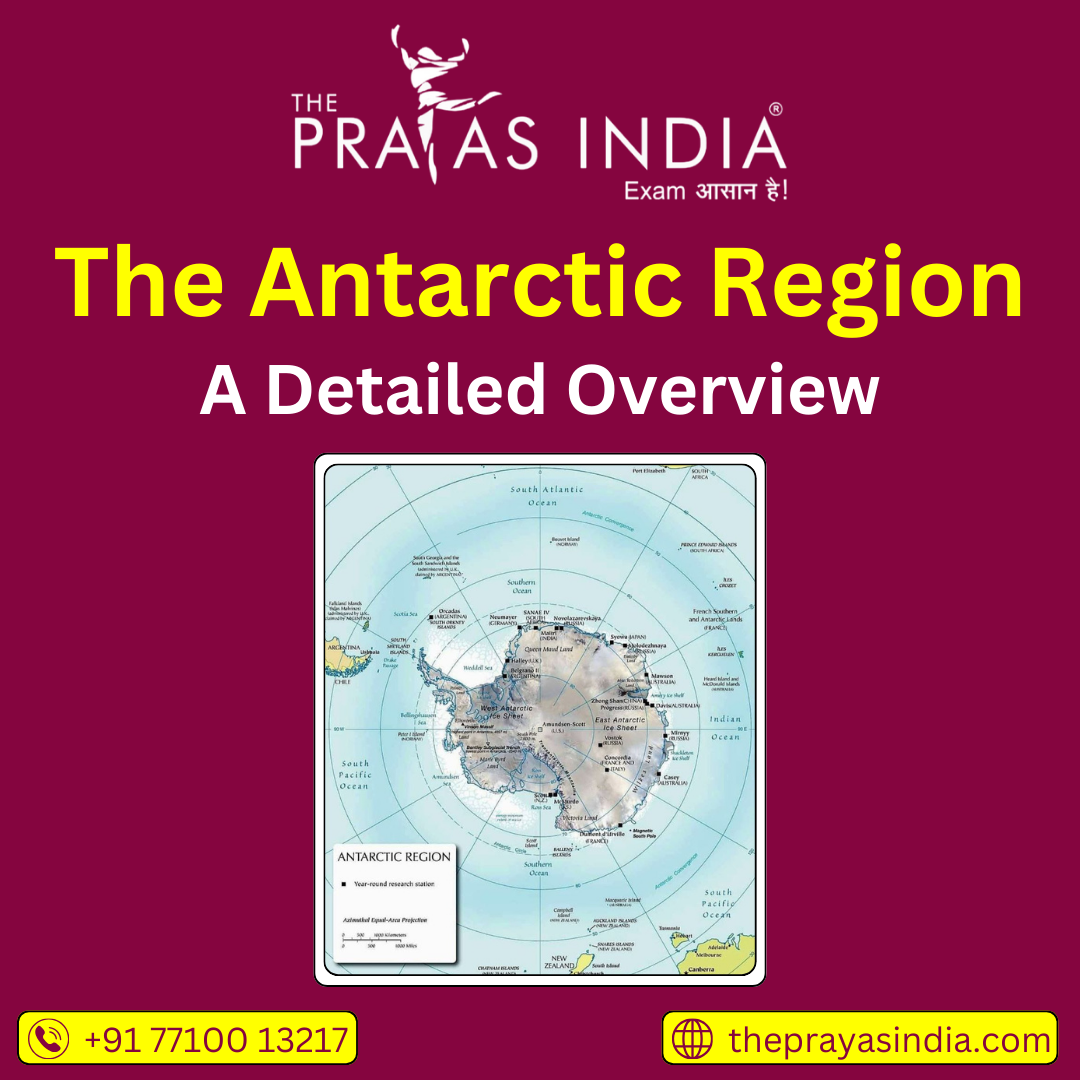The Antarctic Region: A Detailed Overview
The Antarctic region, encompassing the continent of Antarctica and the surrounding Southern Ocean, represents one of the most unique and extreme environments on Earth. Known for its vast ice sheets, pristine ecosystems, and climatic extremities, this region plays a crucial role in global climate regulation and scientific research.
Geographical Features
1. Continent Size and Location
Antarctica is the fifth-largest continent, covering approximately 14 million square kilometers. It is located entirely in the Southern Hemisphere, mostly south of the Antarctic Circle at 66.5° S latitude.
2. The Southern Ocean
The Antarctic continent is surrounded by the Southern Ocean, which forms from the convergence of the Atlantic, Pacific, and Indian Oceans. This ocean hosts rich biodiversity and plays a vital part in global ocean circulation.
3. Landscape
Antarctica’s landscape is dominated by vast ice sheets and glaciers, covering nearly 99% of the landmass. Mountain ranges such as the Transantarctic Mountains divide the continent into East and West Antarctica. The continent also features dry valleys and massive coastal ice shelves like the Ross Ice Shelf and Ronne Ice Shelf.
Climate Characteristics
1. Coldest Place on Earth
Antarctica experiences the lowest temperatures recorded on Earth, dropping below −80°C (-112°F) during the winter. The cold is intensified by its high elevation, with an average elevation of 2,500 meters.
2. Polar Desert
Despite the ice cover, Antarctica is technically a polar desert with very low precipitation, mostly in the form of snowfall, averaging less than 50 millimeters annually in much of the interior.
3. Winds
The continent experiences powerful katabatic winds, which are cold, dense winds that flow downhill from the ice sheet toward the coast, often reaching hurricane speeds.
4. Summer Temperatures
During the austral summer, coastal regions can reach temperatures from -2°C up to 8°C, which allows for limited melting and short bursts of biological activity.
Ice and Glaciers
1. Ice Dominance
Antarctica contains about 90% of the world’s freshwater ice. The Antarctic Ice Sheet is the largest single mass of ice on Earth.
2. Ice Shelves
Key ice shelves include the Ross, Ronne, and Larsen ice shelves, which act as barriers slowing glacial flow into the ocean. Climate change is causing some of these shelves to retreat, affecting sea levels worldwide.
Flora and Fauna
1. Flora
Limited to harsh environments, Antarctic flora consists mainly of mosses, lichens, algae, and fungi. These survive in specialized niches where they endure extreme cold and dryness.
2. Fauna
The region has no native land mammals or reptiles. Marine life is abundant and crucial for the Antarctic ecosystem:
- Birds: Several species of penguins like the Emperor and Adelie, skuas, and petrels.
- Marine mammals: Seals such as Weddell and leopard seals, alongside various whale species.
- Krill and Fish: Antarctic krill are key to the food chain, supporting megafauna and commercial fisheries.
Scientific Importance
1. Climate Research
Antarctica is considered a natural laboratory. Ice cores extracted here provide invaluable climate records dating back 800,000 years, helping scientists understand Earth’s past and future climate changes.
2. Astronomical Observations
Its clear, dark skies make Antarctica ideal for space and atmospheric research.
3. Research Stations
Many countries operate research stations in Antarctica, including India’s Bharati and Maitri, USA’s McMurdo, and Russia’s Vostok. These stations foster international scientific collaboration.
Political Status
Antarctica is unique politically:
- No country owns the continent.
- The Antarctic Treaty System (1959) governs the region, promoting peaceful use, scientific cooperation, and banning military activity and mineral mining.
- More than 50 countries are signatories to this treaty.
Environmental Concerns
1. Climate Change Impact
Global warming is causing melting of Antarctic ice shelves and glaciers, contributing to rising sea levels. Parts of the continent, especially the Antarctic Peninsula, have warmed by nearly 3°C in recent decades.
2. Ozone Depletion
The ozone hole discovered over Antarctica in the 1980s raised global awareness of environmental issues. Though recovering, it remains a concern requiring continuous monitoring.
3. Human Impact
Increasing tourism and activities at research stations necessitate strict environmental regulations to prevent ecological disturbances.
Conclusion
The Antarctic region is a critical component of Earth’s system, influencing global climate, sea-level, and ocean circulation. Its unique ecosystem and political status underscore the importance of international cooperation in preserving its pristine nature. Continuous scientific endeavors here unlock invaluable insights while reminding humanity of its responsibility toward environmental stewardship.


![Prayas-लक्ष्य [UPSC CSE Target] The Prayas India](https://theprayasindia.com/wp-content/uploads/2021/08/Prayas-लक्ष्य-UPSC-CSE-Target-The-Prayas-India-300x167.png)

![Prayas Pre-भेदश [UPSC CSE Prelims Test Series] The Prayas India](https://theprayasindia.com/wp-content/uploads/2021/08/Prayas-Pre-भेदश-UPSC-CSE-Prelims-Test-Series-The-Prayas-India-300x167.png)










